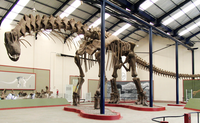
Photo from wikipedia
Abstract The Aptian to lower Cenomanian succession from the Serrania de Cuenca region (Eastern Iberia, Spain) comprises a time-span largely understudied regarding palynology and biostratigraphy. This research studies the deposits… Click to show full abstract
Abstract The Aptian to lower Cenomanian succession from the Serrania de Cuenca region (Eastern Iberia, Spain) comprises a time-span largely understudied regarding palynology and biostratigraphy. This research studies the deposits of three stratigraphic units that crop out in this region (the Contreras Formation, the El Burgal Member and the Utrillas Group), allowing identification, study and sampling of the palynofloras from the Aptian–?early Cenomanian time-interval. The studied sections are grouped into three sectors based on the palynostratigraphic ages obtained: the MPB, TU, and CT sectors, respectively. The palynoflora is dominated by gymnosperm pollen grains and diversified spores of ferns and allies. The palynofloral evidence and regional geology indicate that the sampled levels in the MPB sector are Aptian in age, whereas those levels sampled at the TU and CT sectors are dated as middle Albian–?early Cenomanian. The Aptian palynofloras of this sector differ from other contemporaneous sites of Europe and North America in the possible occurrence of tricolpate angiosperm pollen. In general, angiosperm pollen does not present high percentages; however, it becomes more diversified from the middle Albian in the TU and CT sectors, where more than 20 taxa were recorded on average. The studied pollen assemblages conform with the characteristics of the early Cenophytic palynofloras. Likewise, an increase in dinocysts towards the upper levels of the sedimentary succession in the TU and CT sectors is consistent with the transgressive nature of the deposits, documenting the progressive landward expansion of Western Tethys in Iberia during Albian to ?early Cenomanian times.
Journal Title: Cretaceous Research
Year Published: 2021
Link to full text (if available)
Share on Social Media: Sign Up to like & get
recommendations!